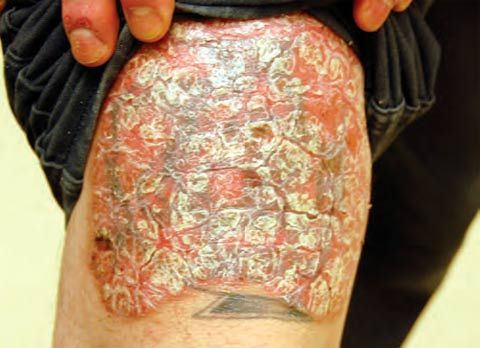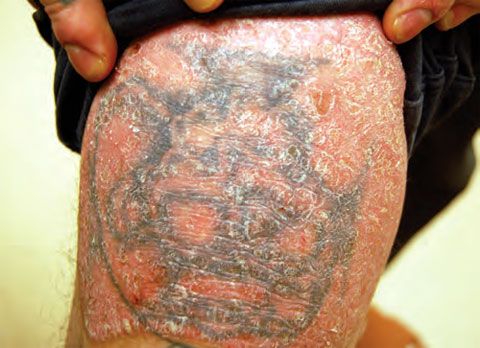- Clinical Technology
- Adult Immunization
- Hepatology
- Pediatric Immunization
- Screening
- Psychiatry
- Allergy
- Women's Health
- Cardiology
- Pediatrics
- Dermatology
- Endocrinology
- Pain Management
- Gastroenterology
- Infectious Disease
- Obesity Medicine
- Rheumatology
- Nephrology
- Neurology
- Pulmonology
Chronic Plaque Psoriasis
Chronic plaque psoriasis in this 37-year-old man was treated with systemic corticosteroids after topical medications proved ineffective. The corticosteroids provided initial relief, but the psoriasis recurred once the medication was discontinued. This patient had been in a county jail for about 18 months; during his confinement, he was not exposed to sunlight.
Chronic plaque psoriasis in this 37-year-old man was treated with systemic corticosteroids after topical medications proved ineffective. The corticosteroids provided initial relief, but the psoriasis recurred once the medication was discontinued. This patient had been in a county jail for about 18 months; during his confinement, he was not exposed to sunlight. Moreover, he was not given emollients and creams. Like most inmates, he had no control over temperature or humidity regulation of his housing unit, which had a tendency to be dry. Also, the choice of medication was subject to a limited drug formulary.
The patient presented to the jail clinic with approximately 40% of his body affected. Physical examination revealed numerous areas of typical oval plaques with sharp, well-defined borders. Red papules that had coalesced into scales were noted in some areas. Most of the scaled areas were extremely dense, most notably on the extensor surfaces and the right anterior thigh (A). The patient had used numerous tattoos located on every major aspect of his body as landmarks to monitor the severity of his flares, and on presentation, only faint outlines of underlying tattoos were exposed.

Figure A
After all other available conservative treatment options were exhausted, the patient agreed to a trial of methotrexate, a gold standard by which other systemic psoriasis medications are measured.1 Methotrexate is recommended for patients with more than 20% of the body affected by chronic plaque psoriasis. A triple-dose method was used. An oral dose of 2.5 mg of methotrexate was given every 12 hours, over a 36-hour period, weekly. Doses were increased in 2.5-mg increments each week until the desired results were achieved.
After 3 weeks of treatment, the patient's condition improved (B) with a total weekly dose of 22.5 mg. Complete blood cell counts and liver function remained stable throughout therapy.

Figure B
The goal of treatment in the setting of psoriasis is control, not 100% clearance. The patient should be treated with the lowest effective dose of methotrexate. This patient had an excellent response to treatment, as evidenced by approximately 95% clearance (C), even though he had no exposure to sunlight during therapy and approximately 4 of 5 persons with psoriasis benefit from daily exposure to sunlight.2

Figure C
References:
References:
1. Saporito FC, Menter MA. Methotrexate and psoriasis in the era of new biologic agents. J Am Acad Dermatol. 2004;50:301-309.
2. Kalb RE, Strober B, Weinstein G, Lebwohl M. Methotrexate and psoriasis: 2009 National Psoriasis Foundation Consensus Conference. J Am Acad Dermatol. 2009;60:824-837.
